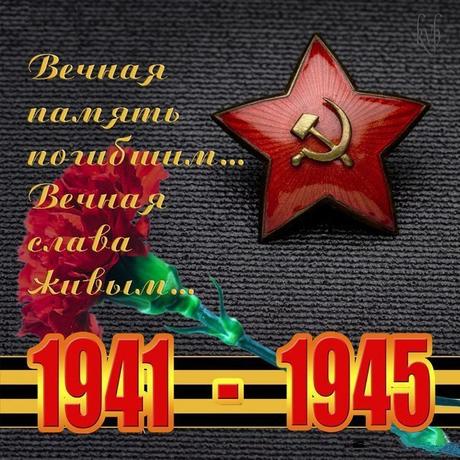Russia's 71st annual Victory Day celebration has come and gone. While each year offers a slightly different feel on a familiar theme, this year apparently carried the theme of military hardware and modernization. Moscow often uses the parade to sent a message to the West regarding Russian military might.
As the parade has grown over the years, special tickets are necessary to attend and security is very tight. Most Russians watch the parade on television, and coverage is mandated on the Kremlin controlled media. The parade was smaller this year with only 10,000 troops marching.
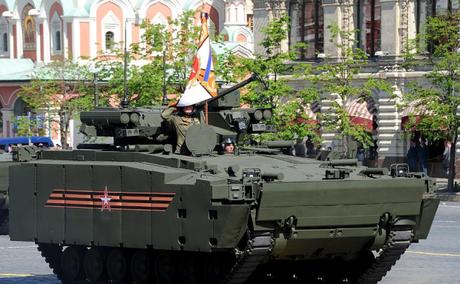
The parade of military hardware on Red Square featured over 130 displays, from Tigr multipurpose vehicles, T-90 and Armata tanks, BTR-82A armoured personnel carriers, BMP-3 infantry combat vehicles, Msta-S self-propelled howitzers, and Buk-M2, Pantsir-S and Yars air defense systems. The airborne feature of the parade was led by a group of Mi-26 transport helicopters, the world's largest.

The parade included an updated version of the Buk antiaircraft missile system, as now identified by Dutch investigators as responsible for shooting down a civilian airliner (Malaysia Airlines Flight MH-17) over Eastern Ukraine on 17 July 2014.
Russia's Commander-in-Chief of the Land Forces Oleg Salyukov was in charge of the parade. The traditional inspection of troops was conducted by Minister of Defense Serei Shoigu.
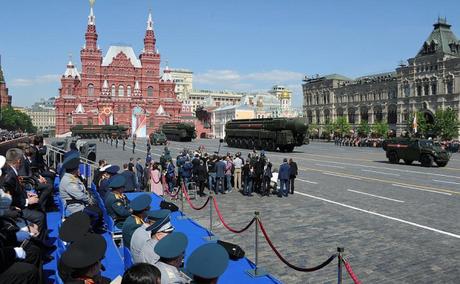
Russian President Putin told the audience on Red Square that the Great Patriotic War of 1941-1945 (WWII) " will always be a sacred deed of our people, a call to live honestly, hold high the bar of truth and justice ...."
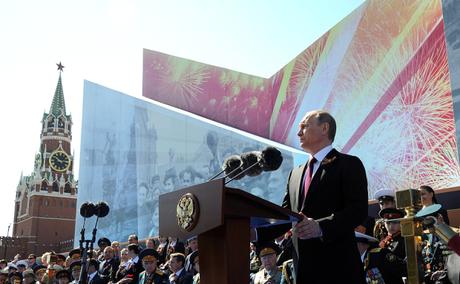
Some of Putin's remarks dealt with the world-wide threat of terrorism: "Today, civilization is again facing cruelty and violence: terrorism has become a global threat. We must defeat this evil; Russia is open to joining efforts with all states and is ready to work on creating a modern, non-aligned system of international security."

The annual Victory Day celebration includes parades, ceremonies, displays and parties in parks. There is a time honoured tradition of citizens giving flowers to veterans. The veterans are decked out, many still able to fit into their wartime uniforms, often glistening with medals.
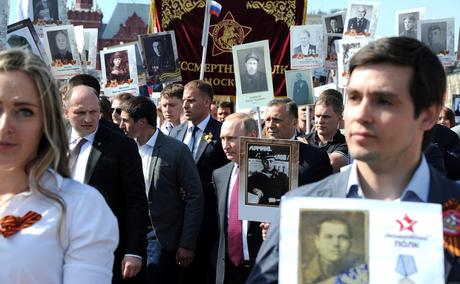
President Putin also took part in the Immortal Regiment Procession, an event that began in the Russian city of Tomsk in 2012. Relatives of soldiers who fought in the war carry placards with a photograph and the name of their relative.
Hardly a Soviet family was spared the pain of losing multiple family members. It is estimated that 28 to 30 million citizens perished; approximately 10 million of the lives lost were military personnel.
Prior to the war, Stalin's purges of the 1930s had decimated the Red Army leadership. The surviving generals were typically young, inexperienced, and not as well educated in the art of warfare. They were simply outclassed by a superior leadership corp that marked the Nazi military leadership.
Poor leadership and decision making, as Stalin often dictated even the smallest of strategy details, is estimated to have led to millions of deaths. Especially in the early phases of the war, the surviving Generals of the Red Army who had experience were often mere instruments for Stalin's directives.
(photos: Presidential Press Service and the Mendeleyev Journal)
